Orpheum Annex | Map
Marc Destrubé, violin; Linda Melsted, violin; Stephen Creswell, viola; Tanya Tomkins, cello; Robert Bringhurst, poet; Jan Zwicky, poet
“Zwicky is exquisitely attentive to the music of being, the music of thought, and the interrelations between the two.”—Governor General’s Award jury citation
“Robert Bringhurst’s sinewy language and acute formal intelligence now reveal poetry of vivacity and stature, which can be enjoyed as a cultural treasure.” – Griffin Poetry Prize judges
“Marc Destrubé bared his soul without reserve, yet displaying gentlemanliness and humility”. Neville Oliffe, Early Music News, Australia
Texts by Robert Bringhurst and Jan Zwicky
In 1785 Josef Haydn wrote a chamber work based on the Biblical seven last words spoken by Christ on the cross. Traditionally, the words or phrases are spoken, followed by a meditation on those words, then by the music. EMV, in collaboration with Green College at UBC, have invited renowned BC poets Robert Bringhurst and Jan Zwicky to prepare poetry for each of the seven movements that stimulates a dialogue based on the universal human qualities in the text and also in Haydn’s deeply affecting music.
Generously sponsored by Mark Vessey & Maya Yazigi and Sherrill & John Grace.
Programme
Introduzione in D minor — Maestoso ed Adagio
Sonata I (“Pater, dimitte illis, quia nesciunt, quid faciunt”) in B-flat major — Largo
Sonata II (“Hodie mecum eris in paradiso”) in C minor, ending in C major — Grave e cantabile
Sonata III (“Mulier, ecce filius tuus”) in E major — Grave
Sonata IV (“Deus meus, Deus meus, utquid dereliquisti me”) in F minor — Largo
Sonata V (“Sitio”) in A major — Adagio
Sonata VI (“Consummatum est”) in G minor, ending in G major — Lento
Sonata VII (“In manus tuas, Domine, commendo spiritum meum”) in E-flat major — Largo
Il terremoto (Earthquake) in C minor — Presto e con tutta la forz
Programme notes
SEVEN LAST WORDS
Franz Joseph Haydn’s Seven Last Words (Opus 51) is a string quartet like no other. To begin with, there are nine movements instead of the usual four. The core of the work is a sequence of seven slow, prayerful, meditative sonatas. These are framed by an intense and substantial introduction and a short, explosive coda. Most of Haydn’s 68 other string quartets, and most quartets written by other composers, consist of movements of varying tempi and character: a fast first movement, a slow, meditative second movement, a brief minuet or scherzo in triple time, and a fast finale. Here, the structure must be different. Haydn’s theme is the Crucifixion. His seven words are the seven short sentences uttered by Christ from the cross, according to the gospels of Matthew, Luke, and John. Breathless tempi, dances and musical jokes have no place.
The work began with a commission from a Jesuit priest in the Andalusian city of Cádiz, on the southwest coast of Spain. Padre José Marcos Sáenz de Santa María (1738–1804) was spiritual director of a Christian gentlemen’s club called the Hermandad de la Santa Cueva (Brotherhood of the Sacred Cave), and administrator of their chapel, the Oratorio de la Santa Cueva. Though officially penniless himself, Padre José came from a well-connected mercantile family, and in 1781, with donations from friends and family, he began to enlarge and remodel his chapel. In 1785 he inherited both an unexpected peerage (by reverse descent from his nephew) and a fortune to go with it. Though still a priest and bound by his vow of poverty, Padre José was now also Don José, the Marqués de Valde-Íñigo. He decided that the wealth suddenly placed at his disposal should also go into the Oratorio’s building fund.
Santa Cueva was once what the name suggests: an underground chapel whose dark stone interior was as plain as a hermit’s cell. Padre José commissioned an architect to add a magnificent oval chapel above the ground, and in due course commissioned Spain’s most celebrated painter, Francisco Goya, to paint three religious scenes for the new building. Music, however, came before architecture and painting. It appears that one of the priest’s first decisions, on receipt of his inheritance, was to ask Europe’s most celebrated composer to write the Seven Last Words.
Haydn turned 53 in the spring of 1785. He was the author of more than 80 symphonies, 34 string quartets, over 60 keyboard sonatas, dozens of operas, masses, and cantatas, and many other works, but he had spent nearly his whole adult life in the private employ of Central European aristocrats. He had only recently been freed to accept paying work from anyone other than his current employer, Prince Miklós Esterházy, and he was still not free to travel except on the prince’s specific instructions. The prolonged visits to London, where he premiered many of his later string quartets and symphonies, were some years in the future. This surprise request from a little Spanish church and a nearly simultaneous invitation to compose six symphonies for Paris were the composer’s first truly freelance commissions.
It is likely that Haydn did not quite understand how small and plain Santa Cueva was at that date, and perhaps this information was deliberately concealed from him. He described the commission in later years as having come from the Cádiz cathedral and spoke of Padre José as a canon or a bishop. But in this case, what Haydn didn’t know did neither him nor his music any harm.
In practical terms, the commission was clear and explicit. Padre José wanted a musical meditation on each of the seven last words of Christ, plus introduction and conclusion, composed for chamber orchestra. On this foundation the priest proposed to mount, in his little chapel or in the grander church of his dreams, the most impressive Easter service Cádiz had ever heard. After a musical introduction, Padre José would utter the first of the canonical seven words and deliver a sermon upon its meaning; then the first sonata would be performed while he prayed before the altar. After seven such sermons and sonatas, the work would conclude with a musical earthquake, announcing Christ’s death on the cross.
Haydn was a serious Roman Catholic, and this commission led him into some of the most reflective and deeply emotional music he ever wrote. It is, however, not clear when the piece was completed. It is often claimed that it was performed in Santa Cueva on Good Friday 1786, but this is unlikely. (The underground chapel was too small, and the upper chapel was not completed for another decade.) The first documented performance – and the first that Haydn could have heard – was in the Auersperg Palace, Vienna, on 26 March 1787. There, in a secular space on a Monday afternoon, there were no sermons. The audience heard nothing but a nine-movement work for chamber orchestra.
The score was published by Haydn’s usual Viennese publisher, Carlo Artaria, in 1787, in three different versions: the orchestral score, a version for string quartet, and a reduction for solo keyboard. The original title for both the orchestral and string quartet versions is Musica Instrumentale sopra le sette ultime Parole di nostro Redentore in Croce (Instrumental Music on the seven last Words of our Redeemer on the Cross). The string quartet and keyboard versions may both have been Artaria’s idea, but Haydn himself did the rewriting required to bring the work within the compass of a string quartet, while leaving the keyboard version to a hired hand. In the string quartet version – completed on 14 February 1787 – the shape and length of the work are essentially unchanged, but in six of the nine movements there are subtle alterations to the parts for all four instruments, showing how Haydn purified the textures in the absence of woodwinds and horns. Many musicians, from 1787 to the present, have preferred this version. (It might also have better suited the Oratorio de la Santa Cueva, given the chapel’s modest size.)
All three incarnations of the score proved popular, and more were yet to come. In the early 1790s, Joseph Frieberth, Kapellmeister of Passau (some 300 km up the Danube from Vienna), produced an oratorio version, basing his text on a popular work by the German poet Karl Wilhelm Ramler. Haydn liked the result well enough that he used it as the basis for an oratorio version of his own, first publicly performed in Vienna in April 1798. In this last and largest incarnation of Seven Last Words, Haydn added clarinets and trombones to the original orchestration and wrote a new tenth movement: a short but chilling interlude for winds and brass to follow the fourth sonata, whose theme is “Why hast thou forsaken me?” The augmented score was published in Leipzig by Breitkopf & Härtel in 1801. The Seven Last Words oratorio also served, not long afterward, as Haydn’s public farewell. He conducted it at his final public concert – in Vienna on 26 December 1803. Earlier that year he had written his last music, the radiant, foreshortened string quartet known as Opus 103. Five years later, he was dead.
Opus 51 has no libretto, yet it does assume the presence of a text. It is designed as a magnificent musical envelope with seven pockets for spoken words. In addition, the canonical seven words themselves – actually seven short phrases from the Latin Bible – are worked conceptually and rhythmically into the texture of the music. The connection was important enough to Haydn that he asked Artaria to print the Latin words underneath the opening bars of the first violin part, to show how the musical phrases rise from the meaning and shape of the text. (One of the things we learn from this is that Haydn pronounced his Latin in the modern Italian, not the Ciceronian, fashion. Another thing we learn is that Haydn, who read his Bible in German, didn’t look the Latin phrases up himself. If he had, he’d have followed the Vulgate exactly, but in fact there are two minor deviations. For the first word, he uses St Augustine’s translation rather than St Jerome’s, and for the seventh word, he uses the version found in the Roman Church’s Compline Service. Perhaps this is a legacy of Padre José’s original commission. In the later oratorio version, Haydn did follow the Vulgate to the letter.)
Even in the 18th century, when Christian ritual and dogma permeated European social life, the combination of music and sermon was not to everyone’s taste. And this particular music seems far closer to prayer than to the pulpit. It is poetic, not hortative or didactic. An Auersperg Palace style of performance, in which the music stands on its own, has seemed to many the best solution. Why add any words, written or spoken, when the envelope itself can deliver the message? But the work still poses a question: Is there anything left to say? Sometimes the answer seems to be yes. And so there have been numerous attempts, beginning with the Passau oratorio, to bring words back into contact with the music, using poetry or song to fill the spaces that, in Haydn’s score, are left to the discretion of a priest.
In 1976, for example, the Aeolian Quartet performed and recorded Opus 51 with the English tenor Peter Pears reading seven poems on Christian themes, composed by seven English poets, from John Donne to David Gascoyne. In 2002, the Brentano Quartet commissioned the American poet Mark Strand to compose and perform a seven-part poem for their performance of Opus 51 at the Rothko Chapel in Houston.
In 2008, the Spanish composer José Peris produced an adaptation of Opus 51 in which the first and second violin lines are rearranged to make room for an intermittent soprano, who sings the relevant Latin phrase at each reappearance of the theme. At the Swaledale Festival in Yorkshire in 2010, the Fifth Quadrant Quartet performed a shortened version of the work in which the sermons were replaced by plainsong, sung by the Benedict Biscop Gregorian Choir.
After all these experiments, and in the face of Haydn’s own wordless eloquence, could there still be something to say? One reason to think there might be is, of course, that the crucifixion has never ceased. Man’s deliberate and vengeful inhumanity to man – and to just about everything else – is no less vivid and casual in the twenty-first century than in the first. So in 2014, when we were invited to supply some words for a performance of Opus 51 by Early Music Vancouver, we said yes. And our theme became what we thought it had to be in our time: the crucifixion of the earth.
— Robert Bringhurst & Jan Zwicky
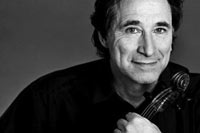
Marc Destrubé, violin
Canadian violinist Marc Destrubé is equally at home as a soloist, chamber musician, concertmaster or director/conductor of orchestras and divides his time between performances of standard repertoire on modern instruments and performing baroque and classical music on period instruments.
As a concertmaster, he has played under Sir Simon Rattle, Kent Nagano, Helmuth Rilling, Christopher Hogwood, Philippe Herreweghe, Gustav Leonhardt and Frans Brüggen. He is co-concertmaster of the Orchestra of the 18th Century with which he has toured the major concert halls and festivals of the world. He was concertmaster of the CBC Radio Orchestra from 1996 to 2002, concertmaster of the Oregon Bach Festival Orchestra, and founding director of the Pacific Baroque Orchestra.
He is first violinist with the Axelrod String Quartet, quartet-in-residence at the Smithsonian Institution in Washington D.C., where the quartet plays on the museum’s exceptional collection of Stradivari and Amati instruments. He has also performed and recorded with L’Archibudelli and is a member of the Turning Point and la Modestine ensembles and Microcosmos string quartet in Vancouver.
He has appeared as soloist and guest director with symphony orchestras in Victoria, Windsor, Edmonton and Halifax as well as with the Australian Brandenburg Orchestra, Portland Baroque Orchestra and Lyra Baroque Orchestra. A founding member of Tafelmusik Baroque Orchestra, he has appeared with many of the leading period-instrument orchestras in North America and Europe including as guest concertmaster of the Academy of Ancient Music and of the Hanover Band.
Marc has recorded for Sony, EMI, Teldec, Channel Classics, Hänssler, Globe and CBC Records.
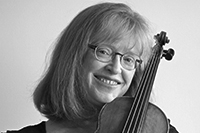
Linda Melsted, violin
The passionate artistry of violinist Linda Melsted has won the hearts of audiences across North America, Europe, and Japan. She has appeared as soloist, member, and leader of many outstanding ensembles including Tafelmusik Baroque Orchestra, Freiburg Baroque Orchestra, Portland Baroque Orchestra, Seattle Baroque Orchestra, Pacific Baroque Orchestra, and Pacific MusicWorks.
Linda is the featured soloist in Tafelmusik’s TV documentary, DVD, and CD “Le Mozart Noir,” where she musically incarnates the remarkable 18th-century virtuoso and adventurer, the Chevalier de Saint-Georges. An active chamber musician, Linda has appeared on many series including Early Music Vancouver, Gallery Concerts, Primavera Concerts, Bloomington Early Music Festival, the Calgary Symphony’s Italian Music Festival, Folia, Toronto Music Garden, Quadra Island Discovery Chamber Music Festival, and Tactus.
Linda was a member of Tafelmusik 1992-2004, Music Director of Nota Bene Baroque Orchestra, 2005-2009, a regular guest leader and soloist of the Kitchener-Waterloo Symphony Orchestra’s Baroque and Beyond series, and taught violin at the University of Waterloo. Happily back in Seattle since 2010, she formed the Salish Sea Players, a group dedicated to performing chamber music in retirement and nursing facilities and directs Seattle’s community Baroque orchestra, the New Baroque Orchestra. Linda performs on a Nicolo Amati violin from 1670.
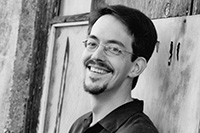
Stephen Creswell, viola
Stephen Creswell is a respected and dynamic performer in the Pacific Northwest. He has appeared on many chamber music programmes with Marc Destrube and Friends, including the complete Mozart Viola Quintets series, and successive performances in Victoria as part of the Pacific Baroque Festival.
In recent years, he has traveled to Dubai with the Seattle Baroque Orchestra, and to Washington, D.C. and Davenport, Iowa to appear with Concerts Spirituel director and flute virtuoso, Jeffrey Cohan. Stephen is a long-time member of the Northwest Sinfonietta, contributes to the educational outreach arm of Seattle Chamber Music Society, and has appeared (on the violin) as concertmaster with both Seattle Pro Musica and the Seattle Choral Company. He performs as a founding member with SCRAPE, a Seattle-based new-music string band featured on Origin Classics Label, and teaches at Music Academy Northwest.
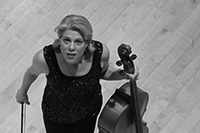
Tanya Tomkins, cello
Artistic Director and co-founder of the Valley of the Moon Music Festival, cellist Tanya Tomkins is equally at home on Baroque and modern instruments. She has performed on many chamber music series to critical acclaim, including the Frick Collection, “Great Performances” at Lincoln Center, the 92nd Street Y, San Francisco Performances, and the Concertgebouw Kleine Zaal.
She is renowned in particular for her interpretation of the Bach Cello Suites, having recorded them for the Avie label and performed them many times at venues such as New York’s Le Poisson Rouge, Seattle Early Music Guild, Vancouver Early Music Society, and The Library of Congress.
Tanya is one of the principal cellists in San Francisco’s Philharmonia Baroque Orchestra and Portland Baroque Orchestra. She is also a member of several groups including Voices of Music and the Benvenue Fortepiano Trio (with Monica Huggett and Eric Zivian). On modern cello, she is a long-time participant at the Moab Music Festival in Utah, Music in the Vineyards in Napa, and a member of the Left Coast Chamber Ensemble. As an educator, Tanya has given master classes at Yale, Juilliard, and the San Francisco Conservatory of Music, and is devoted to mentoring the next generation of chamber musicians through the Apprenticeship Program at the Valley of the Moon Music Festival.

Robert Bringhurst, poet
Robert Bringhurst’s poetry, essays, and translations have won major awards from the Guggenheim Foundation, the Library of Congress, the American Philosophical Society, the Centre Nationale de la Recherche Scientifique (Paris), and the Canada Council for the Arts. Many of his longer poems take the form of “chamber music for speaking voices” – polyphonic compositions that involve the interweaving of several simultaneous texts. His New World Suite No. 3, for example, is a poem for three speakers. His masque Ursa Major (which is set simultaneously in Saskatchewan and ancient Greece) is written for seven voices, speaking together in English, Latin, Greek, and Cree.
Trained as a linguist, Bringhurst has translated from several European, Asian, and Native American languages. His monumental study of Haida oral literature, A Story as Sharp as a Knife, is described by Margaret Atwood as “a profound meditation on the nature of oral poetry and myth.” The trilogy of which it forms a part was chosen as Book of the Year for 2004 by the Times of London.
“Bringhurst comes to us like night lightning,” Barry Lopez has written. “The dark is suddenly lit by language beautifully crafted and by riveting thought. He writes for the eye, the ear, and the mind all at once, and he doesn’t waste a sentence.”
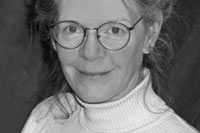
Jan Zwicky, poet
Jan Zwicky is one of Canada’s most respected artists and intellectuals, known equally for her highly original work in philosophy and her intensely lyrical poetry. She has published over a dozen books of poetry, nonfiction, fiction, and translation including Songs for Relinquishing the Earth, which won the Governor General’s Award, Robinson’s Crossing, which won the Dorothy Livesay Prize, and Forge, which was shortlisted for the Griffin Poetry Prize. Her philosophical meditation Wisdom & Metaphor was shortlisted for the Governor General’s Award for nonfiction.
Zwicky obtained her Ph.D. in philosophy from the University of Toronto and subsequently taught at a number of North American universities, including Princeton. As both poet and philosopher, she frequently focuses on the natural world and questions of ecology. In the ’80s and ’90s, she developed and taught some of the first courses in environmental studies at Canadian universities as well as interdisciplinary courses in the humanities, courses in early Greek philosophy and courses in the thought of the Austrian philosopher Ludwig Wittgenstein.
She is also an accomplished orchestral and chamber violinist with a strong interest in baroque performance practice. Individual musical compositions feature frequently in her poems and musical thinking plays a fundamental role in her philosophical thought. Before she moved from Victoria in 2009, she performed regularly with Festival Baroque, the Victoria Symphony, and other ensembles in the area.
Zwicky’s poetry has been published in translation in a number of European languages, and she lectures widely in North America and Europe. A native of Alberta, she now lives on Quadra Island, British Columbia.



